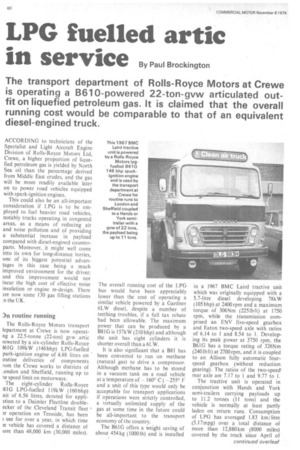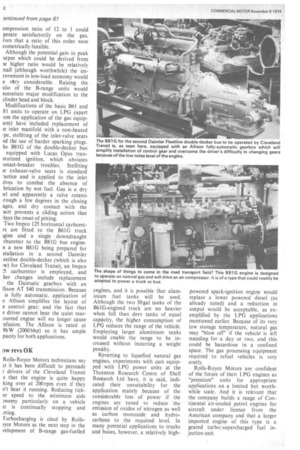LPG fuelled artk
Page 102

Page 103

Page 104

If you've noticed an error in this article please click here to report it so we can fix it.
in service By Paul Brockington ACCORDING to technicians of the Specialist and Light Aircraft Engine Division of Rolls-Royce Motors Ltd, Crewe, a higher proportion of liquefied petroleum gas is yielded by North Sea oil than the percentage derived from Middle East crudes, and the gas will be more readily available later on to power road vehicles equipped with spark-ignition engines.
This could also be an all-important consideration if LPG is to be employed to fuel heavier road vehicles, notably trucks operating in congested areas, as a means of reducing air and noise pollution and of providing a substantial increase in payload compared with diesel-engined counterparts. Moreover, it might well come into its own for long-distance lorries, one of its biggest potential advantages in this case being a much improved environment for the driver; and this improvement would not incur the high cost of effective noise insulation or engine re-design. There :ire now some 130 gas filling stations n the UK.
3n routine running
The Rolls-Royce Motors transport lepartment at Crewe is now operatng a 22.5-tonne (22-ton) gvw artic ■ owered by a six-cylinder Rolls-Royce 161G 109kW (146bhp) LPG-fuelled park-ignition engine of 4.88 litres on outine deliveries of components rom the Crewe works to districts of ,ondon and Sheffield, running up to le speed limit on motorways.
The eight-cylinder Rolls-Royce ;81G LPG-fuelled 119kW (160 bhp) nit of 6.56 litres, derated for appliition to a Daimler Fleetline doubleecker of the Cleveland Transit fleet m. operation on Teesside, has been use for over a year, in which time le vehicle has covered a distance of lore than 48,000 km (30,000 miles). The overall running cost of the LPG bus would have been appreciably lower than the cost of operating a similar vehicle powered by a Gardner 6LW diesel, despite a number of teething troubles, if a full tax rebate had been allowable. The maximum power that can be produced by a B8 I G is I 57kW (210 bhp) and although the unit has eight cylinders it is shorter overall than a 6LW.
It is also significant that a B81 has been converted to run on methane (natural gas) to drive a compressor. Although methane has to be stored in a vacuum tank on a road vehicle at a temperature of 160° C (-255° F and a unit of this type would only be acceptable for transport applications if operations were strictly controlled, a virtually unlimited supply of the gas at some time in the future could be all-important to the transport economy of the country.
The B61G offers a weight saving of about 454 kg (10001b) and is installed in a 1967 BMC Laird tractive unit which was originally equipped with a 5.7-litre diesel developing 78kW (105 bhp) at 2400 rpm and a maximum • torque of 306Nm (2251bft) at 1750 rpm, while the transmission comprised an ENV five-speed gearbox and Eaton two-speed axle with ratios of 6.14 to 1 and 8.54 to I. Developing its peak power at 3750 rpm, the B61G has a torque rating of 326Nm (240 lb ft) at 2700 rpm, and it is coupled to an Allison fully automatic fourspeed gearbox (without reduction gearing). The ratios of the two-speed' rear axle are 7.17 to 1 and 9.77 to 1.
The tractive unit is operated in conjunction with Hands and York semi-trailers carrying payloads up to 11.2 tonnes (11 tons) and the vehicle is normally at least partly laden on return runs. Consumption of LPG has averaged 1.83 km/litre (5.17mpg) over a total distance of more than 12,880km (8000 miles) covered by the truck since April of this year, despite some gas leak troubles in the early days.
While accurate records of the truck's consumption as a diesel-powered unit are not available for comparison it would probably have been around 3.00 km/litre (8.5 mpg) at a lower average speed. Currently the retail cost ratio of LPG/dery is about 30/50, the tax on dery being double the tax on LPG. It could reasonably be assumed that the cost of running an LPG-fuelled truck would be about the same as the cost of operating a diesel-engined equivalent if the LPG/ dery consumption ratio matched the price ratio, and (of special importance) maintenance costs were comparable. In fact the two ratios are of the same order in the case of the B6I G/ diesel comparison. And the first cost of a Rolls-Royce LPG engine is about 50 per cent lower than the price of a diesel developing the same power.
The long life
In the misguided opinion of many operators, the diesel engine has an inherent superiority over a sparkignition unit in terms of mileage life between major overhauls, the truth being that diesels are made to last and petrol engines are normally designed to satisfy the first owners of motor cars and no more. The design of the B-range series dates from the early 1940s and the engines were developed for applications to military combat vehicles, the majority of the 40,000 units produced being currently in military service. RollsRoyce Motors emphasize that a petrol engine (or an LPG-fuelled unit) can have as good a life span as a diesel if it is designed with the appropriate objectives. First marketed in 1947 and extensively employed since then for powering fire appliances and stationary plant, as well as military vehicles, B-range petrol engines have operated satisfactorily as vehicle engines for well over 321,000 km (200,000 miles) without a major overhaul.
Cooler exhaust
Because a gaseous fuel occupies a greater space than a liquid fuel in the cylinder, power output is reduced 7/8 per cent in the case of LPG and 12/14 per cent if natural gas is employed as a fuel. But this should favour longevity, the exhaust temperature of an LPG engine being reduced proportionately. As a petrol engine the B61 is rated at 128kW (172bhp) while the rating of the B81 is up to 175kW (235 bhp). The use of LPG eliminates oil contamination by deposits derived from over fuelling and enables the oil-change period to be extended indefinitely, although Rolls-Royce Motors play safe and advise a change after 19,300 km (12,000 miles). So the B6I G of the Clean Air Truck operated by the Rolls-Royce Motors' Transport department at Crewe could well have a longer life than the diesel engine it replaces. The engine of this vehicle and of the double-decker bus produces about 40 per cent more power than the original unit and this could be typical of future applications, an improved performance at no extra cost — plus a bigger payload — having a special appeal on goods vehicles.
Working independently of RollsRoyce Motors, Roger Denniss, group fleet engineer of Bass Productioi Ltd, is converting a Bedford KGi chassis to operate on an LPG-fuelle, B60 unit, which with a lighter tram mission will give an increase in pa3. load of about 1000 lb, a welcom reduction in the noise level and lowe crankcase emissions. The vehicle wi be used for local deliveries. In th opinion of Rolls-Royce Motors, LP( is best suited to applications wit local delivery vans, psv and utilit vehicles that can be fuelled at th operator's base.
The B61G and B8 IG each have stroke of 114.3 mm (4.5 in) and a boi of 95.25 mm (3.75 in). An overheac inlet and side-exhaust valve layot limits the highest compression rati that can be employed to 8 to 1 f( physical reasons. LPG has an octar rating of 125 and an engine with ompression ratio of 12 to I could perate satisfactorily on the gas, iven that a ratio of this order were eometrically feasible.
Although the potential gain in peak utput which could be derived from ie higher ratio would be relatively mall (although worthwhile) the imrovement in low-load economy would e very considerable. Raising the itio of the B-range units would ecessitate major modification to the vlinder head and block.
Modifications of the basic B61 and 81 units to operate on LPG (apart 'om the application of the gas equiptent) have included replacement of ie inlet manifold with a non-heated 7pe, stelliting of the inlet-valve seats ad the use of harder sparking plugs. he B81G of the double-decker bus equipped with Lucas Opus transtorized ignition, which obviates )ntact-breaker troubles. Stelliting le exhaust-valve seats is standard -actice and is applied to the inlet lives to combat the absence of brication by wet fuel. Gas is a dry !el and apparently a valve rotates !rough a few degrees in the closing ages, and dry contact with the sert prevents a sliding action that :lays the onset of pitting.
Two Impco 125 horizontal carburetrs are fitted to the B61G truck tgine and a single downdraught rburetter to the 1381G bus engine.
n a new B81G being prepared for stallation in a second Daimler eetline double-decker (which is also Iv) for Cleveland Transit, an Impco 15 carburetter is employed, and her changes include replacement the Daimatic gearbox with an llison AT 540 transmission. Because is fully automatic, application of e Allison simplifies the layout of e control gear; and the fact that e driver cannot hear the quiet rearnunted engine will no longer cause nfusion. The Allison is rated at 9kW (2000 bhp) so it has ample pacity for both applications.
Cow revs OK Rolls-Royce Motors technicians say tt it has been difficult to persuade 2: drivers of the Cleveland Transit s that the engine is quite happy king over at 200 rpm even if they n't hear it running. Reducing ticker speed to the minimum aids )nomy particularly on a vehicle it is continually stopping and .rting.
Turbocharging is cited by Rollsayce Motors as the next step in the velopment of B-range gas-fuelled engines, and it is possible that aluminium fuel tanks will be used. Although the two 50gal tanks of the B61G-engined truck are no heavier when full than dery tanks of equal capacity, the higher consumption of LPG reduces the range of the vehicle. Employing larger aluminium tanks would enable the range to be increased without incurring a weight penalty.
Reverting to liquefied natural gas engines, experiments with cars equipped with LPG power units at the Thornton Research Centre of Shell Research Ltd have, it is said, indicated their unsuitability for the application mainly because of the considerable loss of power if the engines are tuned to reduce the emission of oxides of nitrogen as well as carbon monoxide and hydrocarbons to the required level. In many potential applications to trucks and buses, however, a relatively high powered spark-ignition engine would replace a lower powered diesel (as already noted) and a reduction in output would be acceptable, as exemplified by the LPG applications mentioned earlier. Because of its very low storage temperature, natural gas may "blow off' if the vehicle' is left standing for a day or two, and this could be hazardous in a confined space. The gas processing equipment required to refuel vehicles is very costly.
Rolls-Royce Motors are confident of the future of their LPG engines as "premium" units for appropriate applications on a limited but worthwhile scale. And it is relevant that the company builds a range of Continental air-cooled petrol engines for aircraft under licence from the American company and that a larger imported engine of this type is a geared turbo/supercharged fuel injection unit.




































































































































































































